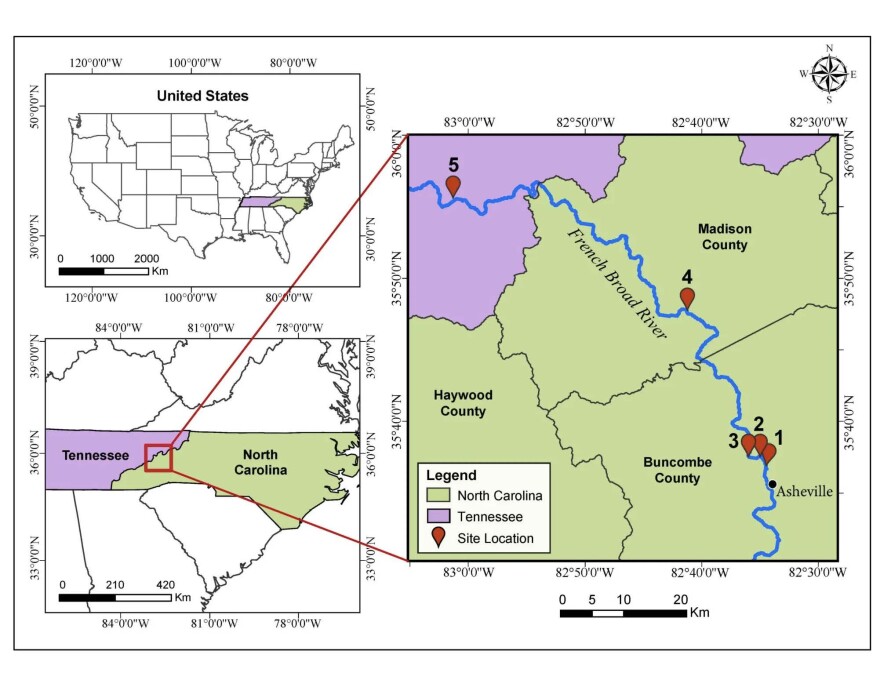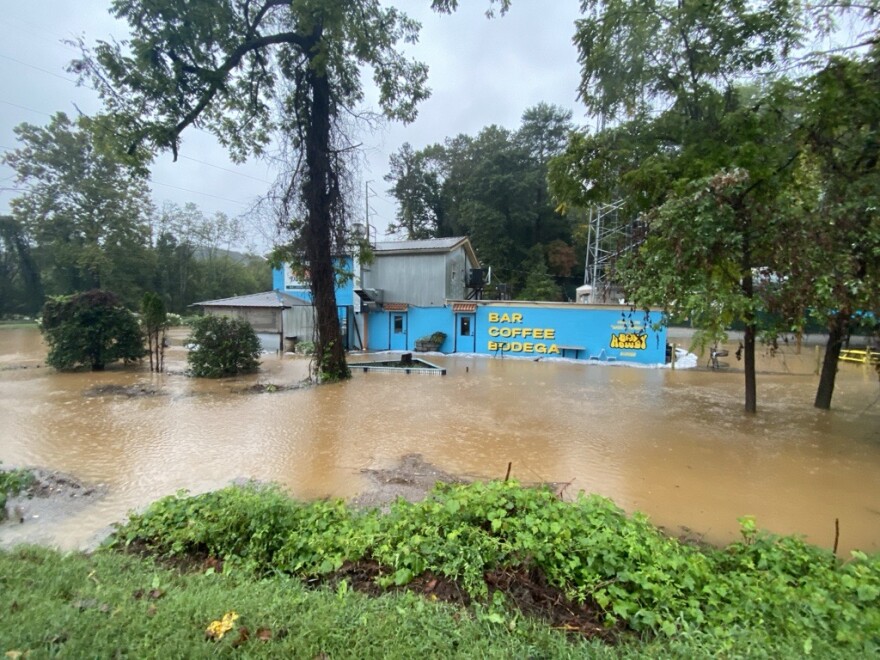Fifteen days after Tropical Storm Helene sent debris, runoff and a cocktail of toxins — including raw sewage and pharmaceuticals — pouring into the French Broad River in the fall of 2024, Shea Tuberty set out to investigate the damage.
The storm had carved an improbable path from the Florida Gulf Coast into the North Carolina mountains, taking lives and tearing apart communities. Days after it passed, Tuberty — a professor in Appalachian State University’s Department of Biology who’s known by friends as “the water guy”— said he was contacted by friends downstream in Tennessee who asked him to collect water samples to test for contaminants.
The disaster stirred painful memories for Tuberty,
“I’ve got PTSD from back in my 20s, when I lost my sister to a Middle Tennessee flood on Christmas Eve,” he said. “So this all had a personal, horrifying impact on me.”
Tuberty said his friends who live near the North Carolina border in the Cherokee National Forest didn’t trust what they were hearing from local or federal authorities as they were working to clean up Hot Springs, N.C., the closest community to their home. They peppered him with questions about the river.
“‘We’re working all day long in the sediment left behind by Hurricane Helene. What’s in the sediment a
nd dust we’re breathing in? What’s in the water? Are we safe? Should we even be here?’” Tuberty said they asked him.
Seeking help
Before collecting water samples along a stretch of the river that flows from Asheville to Tennessee, Tuberty said he knew he’d need help analyzing them.
Earlier that week, while preparing to attend the North Carolina Society of Toxicology meeting at Research Triangle International, he called colleagues to find out who might be able to conduct a general chemical analysis. But identifying every chemical individually would have been far too expensive and time-consuming — and he had no grant funding to support the work. A colleague told him to speak with Imari Walker-Franklin. Tuberty found her soon after she gave the keynote address at the conference, and they agreed to work together to provide information regarding the contaminants in the river.
Walker-Franklin, a research scientist at RTI, had the knowledge and technology to conduct the tests. She and her team used high-resolution mass spectrometry — a process that separates chemicals in the water and measures their molecular characteristics.

The technique can detect thousands of contaminants at extremely low levels, including ones scientists aren’t necessarily looking for. Walker-Franklin performed a non-targeted analysis of samples collected 15 days after the storm from five sites along an 80 kilometer (50-mile) stretch of the French Broad River.
“Site 4B was near where a wastewater ramp was impacted [by the storm],” Walker-Franklin said. “Which they could see was the obvious [source of] sewage input into the river.”
Toxic soup
The findings of the study, co-authored by Walker-Franklin, Tuberty and others, were published in October in the journal Toxics.
The analysis revealed that storm runoff created a toxic chemical soup in the river.
“It was literally everything stored in people’s garages,” Tuberty said. “Everything in their kitchens, everything in their basements, everything in their storerooms — all the businesses that line the rivers.”
According to the study, hurricanes can wash a wide range of contaminants into rivers — everything from sewage and roadway chemicals to industrial materials, pesticides, pharmaceuticals, and per- and polyfluoroalkyl substances known as PFAS. The French Broad River’s heavy recreational use, ecological value and history of flood damage make it especially vulnerable to this kind of chemical surge.
Among the chemicals detected were 11 types of PFAS, including PFOA and PFOS, which the study found at levels exceeding the Environmental Protection Agency’s maximum contaminant levels of 4 parts per trillion. PFAS are often called “forever chemicals” because they don’t break down easily in the environment. They have been linked to health risks including cancer, immune system suppression, thyroid disease, developmental harm and elevated cholesterol.
The analysis also detected four EPA “priority” contaminants: 4-nitrophenol, 2,4,6-trichlorophenol, pentachlorophenol and dibutyl phthalate.
The analysis traced the likely source to a stretch of the river identified as Site 4B, an area downstream from Asheville.

“The primary objective of this study was to inform disaster-response monitoring efforts by applying a hazard profiling framework,” according to the paper.
To better understand the risks from the contaminants identified in the samples, the research team used a method known as cheminformatics-based hazard screening. The EPA describes these tools as computer models that use chemical structure and existing data to predict which contaminants may pose health or ecological risks — even when they haven’t been widely tested.
Seeking higher ground
A year later, experts say the water quality in the river has improved.
“A lot of things that probably were present at the time have either settled or transformed, or have been uptaken in some capacity,” Walker-Franklin said. “I don’t think the water that we see today is probably what we saw post-storm.”
French Broad Riverkeeper Anna Alsobrook agrees.
“We did pretty extensive analysis after the storm,” Alsobrook said, “looking at all kinds of pollutants, from bacteria to diesel- and petroleum-based products and other types of chemicals […] because folks were really concerned about getting into the flooded sediments to muck their businesses and homes down.”
She added, “Where we are now, it’s very similar to what we saw before the storm.”
Alsobrook noted that over time, some contaminants break down, get flushed downstream or settle into river-bottom sediment.
When considering the study’s broader implications, Walker-Franklin said the real lesson is vigilance: People should treat river water with caution after major storms. She said it’s important to understand that these types of analyses are a starting point for uncovering potential risks — not a reason for panic, but for better preparedness.
Tuberty said the findings should prompt a deeper conversation about how communities build near waterways.
“We need to have policies and laws put into place for guiding people away from likely loss-of-life situations, moving forward,” he said. “All of these compounds that ended up in the water could have been prevented if we didn’t have sewer plants, industry and storehouses with chemicals that are known to be toxic right on the banks of the river.
“There should be guidance created from either the state of North Carolina or EPA calling for a buffer between you and that river — not just distance, but also elevation.”
North Carolina Health News is an independent, non-partisan, not-for-profit, statewide news organization dedicated to covering all things health care in North Carolina. Visit NCHN at northcarolinahealthnews.org.






